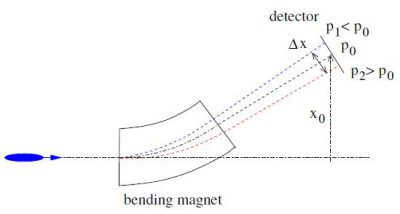Electron Beam Parameter Measurements
Beam diagnostics and instrumentation are an essential part of any accelerator. Various parameters need to be measured for the observation of particle beams in order to tune, operate and improve the performance of the machine.
1.1 Electron beam energy/energy spread measurement at AREAL linac
One of the main parameters of interest is the beam energy. In synchrotron light sources (storage rings, as well as free-electron-lasers) it defines the power and spectral characteristics of the emitted radiation. In electron accelerators, the energy distribution of the electron beam is another essential parameter for the study of longitudinal beam dynamics and beam instabilities. The measurements of electron beam energy (momentum) and energy spread (momentum spread) are done with a magnet spectrometer. The spectrometer transforms the momentum and momentum spread into position and position spread which are measured by a spatial resolving detector (for example, YAG screen). The working principle of YAG screens relies on the interaction of beam particles with a YAG:Ce crystal. A part of the deposited energy results in excited electronic states which de-excite partially via light emission. Therefore, the beam profile can be observed via a CCD camera.


1.2 Electron beam transverse emittance measurement at AREAL linac
Emittance is an important property of charged particle beams, allowing the description of beam quality and comparison of beams. One of the most challenging directions in electron beam physics is the generation of high brightness powerful shortwave electromagnetic radiation for which it is mandatory to produce charged particle beams with low emittance. Two different techniques for measuring the transverse beam emittance, namely, solenoid/quadrupole scan and pepper-pot techniques will be covered in the proposed experiment giving a possibility to crosscheck the results. The underlying principle of solenoid/quadrupole scan technique is to measure the transverse size of the particle beam as a function of the magnetic field strength of a solenoid/quadrupole magnetic focusing lens at a beam size detector (for example YAG screen) located downstream.


Schematic layouts of solenoid and quadrupole magnets
The pepper-pot technique can yield simultaneous information about a beam profile and angular divergence in a single measurement. The beam is screened upstream of the monitor by a “pepper-pot plate”, which contains a regular array of identical holes. The plate stops the beam, allowing only the beam incident on a hole to pass through to the profile monitor. The total intensity of each beamlet as a function of the position of the defining hole still provides a spatial profile of the beam. The profiles of individual beamlets can be used to extract information on the angular distribution of the beam at the position of the hole defining the beamlet.

For the evaluation and preparation of measurement results an introduction to Python/Matlab and a description about handling the dedicated programs is offered.
